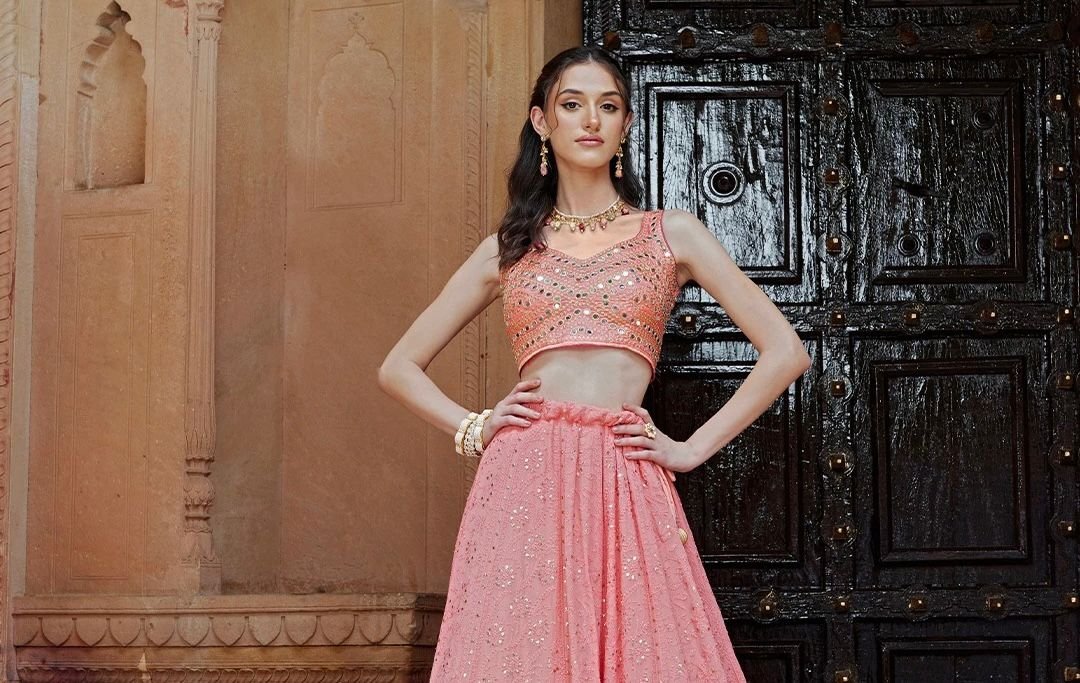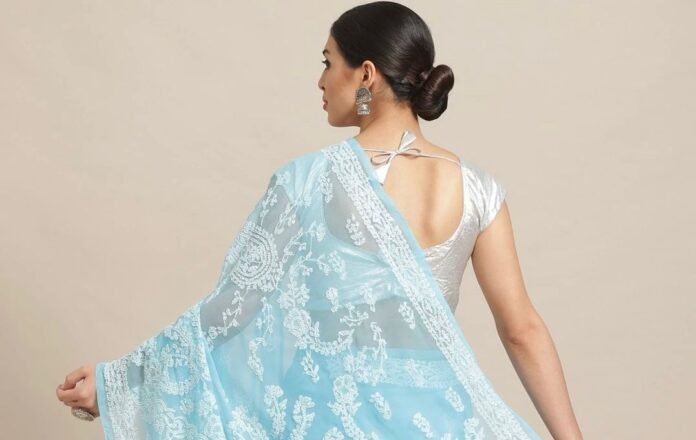Some clothes are designed for ceremony. Others for comfort. Chikankari has both. What was once a craft based in small workshop settings in Lucknow is now a standard in contemporary festive dressing. Its beauty is its understatement. There is no overdoing, no overstatement. Only fabric that drapes, and embroidery that captures the eye without asking for attention.
As occasionwear shifts towards lighter silhouettes, Chikankari becomes all the more pertinent. Brides opt for it for pre-wedding ceremonies. Guests adorn themselves in it for festivals, family get-togethers, and long nights where comfort and beauty are of equal concern. The motifs are trendy without being transient. They hold good in natural light, moonlight, and all shades in between.
Here are some of those time-tested Chikankari silhouettes that still seem ageless, and why that is.
The Chikankari Saree
The Chikankari saree is simple. It has tradition, not baggage. It is not boisterous, but it takes over the room. Constructed from light materials such as georgette, mulmul, or chiffon, it falls attractively and is comfortable day and night.
Hues are subdued. Pastel pinks, gentle greens, light blues, and traditional ivory tones are the general trend. There may be touches of mukaish or light beads, but these are utilized to add emphasis to the embroidery, not encase it. With a plain blouse and small understated accessories, the saree is complete. No styling angst, no frumpy layers.

It is suitable for most events. From morning functions to evening celebrations, this saree seamlessly adapts without losing its classy presence.
The Chikankari Kurti
The kurti has also evolved. What used to be casual has turned into a go-to for party functions. Its sophistication in cut and material paired with careful positioning of embroidery has turned the Chikankari Kurti into a benchmark for occasions calling for restrained refinement.
Newer designs feature A-line figures, flared bottoms, and plain panels. Wear them with shararas, palazzos, or tapered pants, depending on the hue of the occasion. Decoration tends to manifest in the form of neckline, sleeves, or bottom. The remainder of the attire will most likely be plain, with the fabric doing the talking.
Fabrics such as organza, cotton-silk, and soft georgette give it the shine. The kurtis are trendy, becoming, and easy to re-wear in various settings.
The Chikankari Lehenga
Lehengas are apt to awe, but Chikankari takes a different tack. It eschews heavy sequins for intricately detailed threadwork. The embroidery is evenly distributed throughout the skirt, usually in tonal shades that add depth, not bulk.
Blouses are simple. Capped or sleeveless with or without three-quarter sleeves with little or no embellishments is common. The dupatta is light and intricately worked along the edges with just enough finish to bestow a look upon it.
A Chikankari lehenga is ideal for outdoor weddings, destination weddings, or receptions where convenience is an issue. They are light, airy, and visually appealing without overwhelming.
The Chikankari Suit
Few garments are more adaptable than the Chikankari suit. Whether dressed up for a special occasion or dressed down for a family gathering, it adapts well and gets dressed up easily. The three-piece outfit – kurta, bottom, and dupatta – offers comfort, shape, and enough visual appeal to stand on its own.
Embroidery is normally carried out on the neckline, cuffs, or hem. The rest of the suit is plain, with the trim taking center stage. Materials like chiffon, cotton-silk, or georgette create the suit light but firm.
This is a versatile look. Flats and subtle jewellery do for the day. Heels and dramatic earrings see it through the evening. It can be worn repeatedly without turning repetitive.
The Chikankari Hybrid
Chikankari is not anymore limited to conventional silhouettes. It now comes in fusion wear such as jacket sets, draped sarees, high-waist pants with crop tops, and pre-stitched co-ords that combine Indian handiwork with contemporary tailoring.
In these fashions, embroidery is selected placement. A panel here, a cuff there. The aim is to add structure, not detract from it. This calculated policy makes the clothing feel modern while still being rooted in heritage.
These garments are appropriate for modern celebrations. Cocktail affairs, destination weddings, and contemporary weddings provide the ideal backdrop for hybrid Chikankari ensembles. They’re different, yet still recognizable.
Ada Designer Chikan Studio
Much of Chikankari’s current relevance comes from studios that remain committed to its roots while updating its presentation. Ada Designer Chikan Studio is one of the few that gets this balance right. Their garments feature authentic hand embroidery alongside clean, wearable silhouettes.
The ranges feature sarees, lehengas, suits, and kurtis that are intended for reuse. Seasonal pastels and richer, deeper shades form the colour palette. Cuts are considered, fabrics are select, and embroidery is finished by skilled workers who know both the design and the heritage aspect of the effort.
Nothing is overdone. These are clothes that are built to last and built to be loved with every wearing.
What Makes Chikankari So Wearable
Chikankari clothing doesn’t just look nice. They feel nice too. The fabrics are light as a feather. The embroidery provides detail without adding bulk. The cuts flatter without constricting. All of these things combined make Chikankari garments easy to come back to time and time again.
Every piece is versatile. A kurti to the daytime event can be reworked for an evening gathering with a jewelry change. A saree and flats today can be styled up with heels and a contrasting blouse tomorrow. It is occasionwear that adapts to the moment.
It is mobile. It honors the comfort of the wearer. And it imparts poise without the customary effort.
Wearing What Lasts
Fashion tends to shift swiftly, however. What seems appropriate one season may seem tired the next. But Chikankari is different. It develops slowly. It stays rooted in form and technique, but even as palettes and cuts change, it continues on without fanfare.
Wearing Chikankari isn’t about making a statement. It’s about showing up properly, looking put together, and feeling comfortable. The embroidery never attempts too much. It supports instead of demanding.



